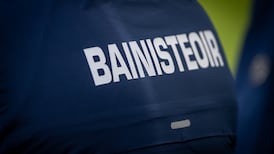Ten years ago, in the Munster hurling final, just before half-time, Cork’s Patrick Horgan was shown a red card after his hurl had made contact with the headguard of Limerick’s Paudie O’Brien. It was accepted that it wasn’t malicious but more ill-judged.
Limerick went on to win their first provincial title in 17 years that day and Cork were unhappy at the dismissal of one of their leading forwards.
The problem for Cork and Horgan was that referees had been instructed to take a zero tolerance approach to any head contact. Anything reckless, ie not having due regard for the safety of an opponent, was to be rigorously penalised.
On Sunday in Thurles there were a number of head-high challenges. Barry Nash was yellow-carded just before the break for catching Stephen Bennett on the head with his hurl – he immediately acknowledged it – and later Bennett for a similar infraction against Diarmaid Byrnes.
READ MORE
Gearóid Hegarty was sent off in the 47th minute, on a second yellow, for a challenge on Conor Gleeson that clattered the Waterford player on the head as the ball was going out of play. It was a very generous second yellow and Limerick could have had few complaints had it been straight red.
[ Wearing protective headgear for sport does not prevent concussion, experts warnOpens in new window ]
Another head-high challenge on Bennett within a couple of minutes of the Nash incident saw Séamus Flanagan catch the Waterford joint-captain with his shoulder.
Although no action was taken by Galway referee Liam Gordon, Flanagan won’t be investigated by the Central Competitions Control Committee (CCCC), as it was indicated at the time that the action was seen as accidental.
That’s quite a portfolio of head shots for a few minutes in the first match of the Munster championship.
The sporting public is familiar with the difficulties in rugby caused by dangerous aerial challenges. In theory it’s zero-tolerance – in other words lack of intent is immaterial.
This can lead to what appear harsh incidents of sendings-off but does it make players more conscious of their opponents before challenging in the air?
Of course it does.
The problem for rugby is not the harshness of the sanction but the inconsistency with which it is applied.
Football and hurling are not collision sports in the same sense as rugby but they increasingly involve ferocious contacts. Players are bigger and stronger. In the words of one intercounty referee from a couple of years ago, “if you’re 6ft 2in and spending six months in the gym, you want to put it to some use”.
Concussion has become an issue for the GAA as well.
One view in hurling is that the requirement to wear a protective headguard or helmet inspires a complacency in players that their opponents are fully protected, thus fraying the constraints on careless and reckless use of the hurl.
Another is that the shorter and lighter nature of the hurl has made it more like an extension of the arm, according to one official.
“A lot of the problem now is that the length of the hurl is short. It means that it’s much lighter. That also means that it’s being swung around the head in an attempt to go for the ball whereas before, if the ball was there to be played more often than not, you’d put you hand in.
“Now you flick with the hurl and you can catch the head, the elbow rather than try to grab the ball. It’s like the hurl is an extension of the hand. That’s the way it’s gone.”
Neither is headgear a complete protection. It helps to prevent laceration and such injuries but in the words of another informed official, the helmet is “irrelevant” when it comes to concussion or brain injury.
Ger Ryan was chair of the GAA’s Medical Scientific and Welfare Committee (MSWC) when increased penalties were introduced for interfering or tampering with an opponent’s helmet – elevated to a red card.
“That was one of the reasons that the ‘interference’ with the helmet rule was brought in. If you’re running and I grab your helmet, it may not impede you but it may impact on your brain, which is now travelling at a different rate to the head, which is a layman’s explanation of contrecoup brain injury.”
Last year, it was emphasised to GAA referees: “Players are responsible for the contact that they make. It doesn’t matter whether it was accidental. If he is responsible for the contact that he makes, then he has to take the repercussions of that contact.”
The GAA has its own concussion management protocols in place for 10 years but there is still uncertainty about what role a referee can play. In rugby it’s not uncommon for a player to be required to leave the field for head injury assessment.
That intervention is rare in Gaelic games despite the provision for it having been included in the rules governing other temporary replacements in a motion accepted by congress in 2021.
Before that congress Dick Clerkin, then chair of the MSWC, explained the need for the new regulation.
“Experience is telling us both anecdotally from speaking with players and from qualitative and quantitative studies that there are cases when there are head injuries and players aren’t being removed for assessment.”
Aside from that, there is an onus on players to curb reckless behaviour. Judging by Sunday in Thurles, there needs to be intensified enforcement when it comes to head injuries inflicted on the field of play.
The least players can expect is that opponents won’t set out deliberately to hit their heads but there has to be a higher standard of care than that.
















